#Atmel
Explore tagged Tumblr posts
Text
Last time on this blog, I made an ATTINY85 flash an LED
This time I made it turn on two different LED’s with a simple push of a button! (Warning; video has pulsing LED’s)
[VIDEO ID: a breadboard with a PDIP8 ATTINY85 microcontroller on it. There is a button next to it, and two LED'S connecting away from it; A yellow and a green. When the video starts, the yellow turns on, but every time a white human finger pushes and holds the switch, the yellow turns off and the green turns on. END ID]
This program will turn one LED on, but if you push the button it will turn it off and activate the other LED. The LED’s will alternate who’s on and off, and this is directly controlled by the tact switch
This one took a bit to code because I forgot how computers count!! And I knew better too!! I had all the bytes coded for 1,2,3,4 counting when computers count as 0,1,2,3. Very embarrassing 😔 Alas, here’s the assembly code I made for it :)
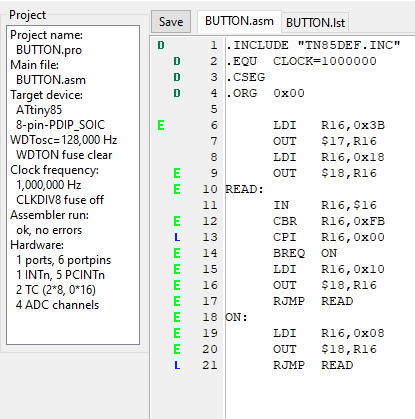
My next step is to make it count two pulses based on a toggled input. While one switch is pushed, count the other switch to see how many pushes it has before the first switch is released. Then, once it gets the count, flash an LED the same number of times.
15 notes
·
View notes
Text
Nucleus
Nucleus – a real-time operating system for the embedded systems market from https://archiveos.org/nucleus/

2 notes
·
View notes
Text
Into the blue again
youtube
I don't want my mom to die. Nothing feels real anymore.
0 notes
Text

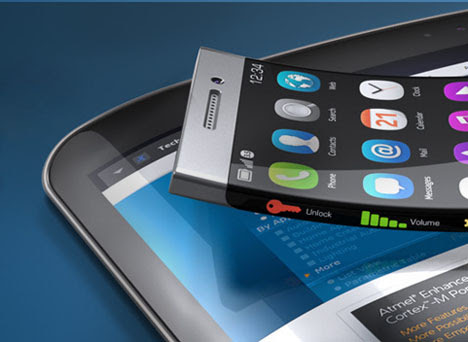

Atmel XSense Touch Sensors : Super Flexible Screens
#2012#2010s#atmel xsense#art#design#frutiger aero#graphic design#graphics#mobile#phone#tablet#techcore#tech#technology#touchscreen
29 notes
·
View notes
Text
Última Llum, entre atmellers
atardecer #sunset #capvespre #vesprada #soirée #bluehour #blue #colorsdelpaisatge #paisajesvalencianos #natura #nature #naturaleza #baixmaestrat #castelló #atmeller #flowers #flor #tree #arbres #skyline #cabanes #pedraseca #vidarural #bancal




#Última Llum#entre atmellers#atardecer#sunset#capvespre#vesprada#soirée#bluehour#blue#colorsdelpaisatge#paisajesvalencianos#natura#nature#naturaleza#baixmaestrat#castelló#atmeller#flowers#flor#tree#arbres#skyline#cabanes#pedraseca#vidarural#bancal#turismecomunitatvalenciana#paísvalencià#light
2 notes
·
View notes
Note
Do you have a favourite rotary telephone?
Excellent question!
Yes, I have a favorite:

The Northern Electric Pyramid phone from about 1935. I had this on my desk at my old job, tied into the telephone system. Its distinctive ring made it really easy to discern if I was the one being called instead of my coworkers. The chrome dial and the area code indicate that this unit came from Canada.
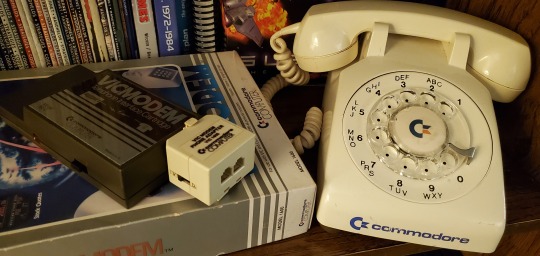
Coming in second place is my Northern Telecom 500-style set with official Commodore branding -- also from Canada. These were sold with VICMODEMs in a special bundle exclusively in the Canadian market. The VICMODEM requires that you detach the cord from the handset, plug it directly into the modem, then dial for the computer.
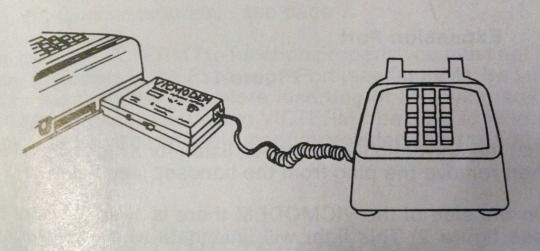
Problem is that you can't do that here, because the handset cord is permanently attached! Solution? The little white adapter box called the VIC 1605. Very hard to find, but I found one.

Coming in third place would be the Contempra from Northern Electric/Telecom from 1967 (why do these keep being Canadian?). Beautiful colors, angles. Great phone, but sadly I don't have one. Atleast not one like this... NT made these into lineman's test sets (commonly called butt sets because they hang on a lineman's belt by their butt/you use them to butt-in to a call when testing things).
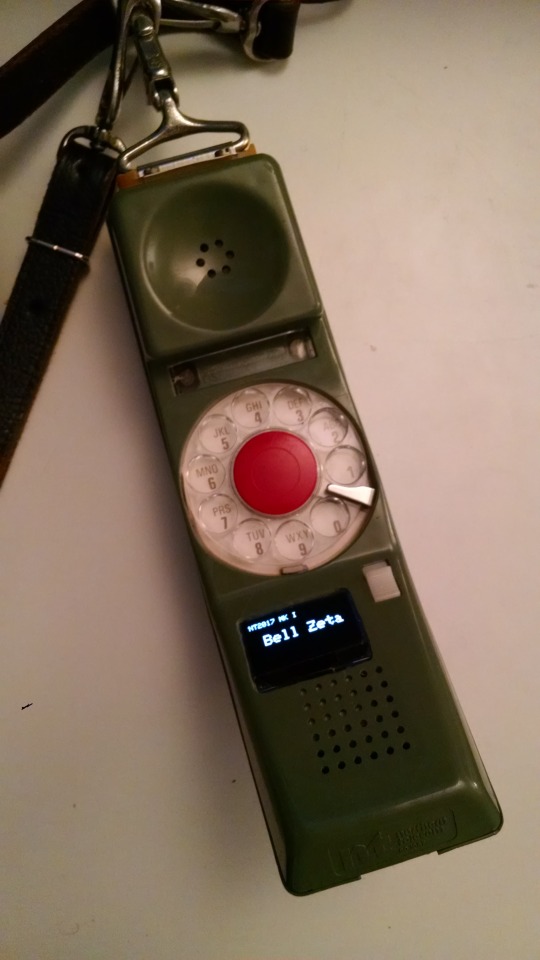

I bought one and turned it into the NT2017 Rotary Cellphone, a real working 2G cellular telephone. It's got an Adafruit Fona board inside with an Atmel 32U4 microcontroller, a little screen, and zero ability to send/receive text messages. It didn't work very well, but it was really fun to build and use before it broke. Construction was very fragile, and my code running it was hot garbage. Since the discontinuation of 2G cell service, it's just decorative at this point.
The last one of my favorites is one I certainly don't have: a late 19th century Skeleton Telephone from Ericsson. Technically not a rotary phone, but it does have a crank that you rotate!
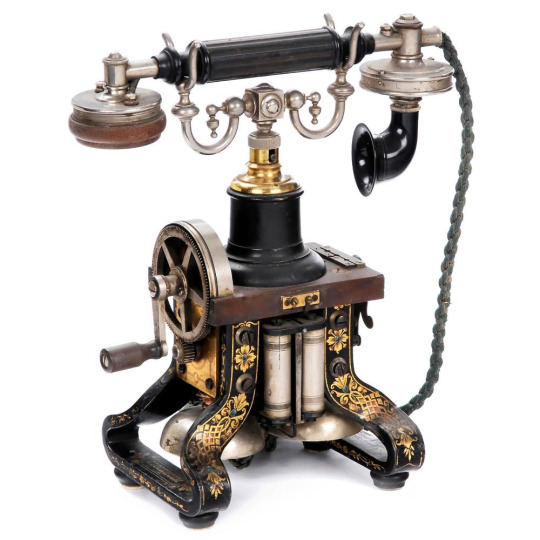
These are expensive, really hard to find, and obviously rather difficult to use without having an operator to ring up when you turn the crank. However, they are stunningly beautiful, and all of the functionality is on display arranged in such a way to accentuate the elegance of its industrial design.
How about you? Do you have a favorite rotary phone?
108 notes
·
View notes
Text
Arduino Nano Board R3 with CH340 chip

Based on the Arduino platform, the Nano R3 Board CH340 Chip without USB Cable does all the functions of the Uno, but has a smaller footprint.
Using Nano CH340 Soldered Board R3 Chip without USB cable is essential for your small project where you don’t need many pins, but the small size is very important to make it look nice.
In comparison to older versions of Arduino Nano with FTDI USB-Serial Chip, the Nano uses a low-cost USB-Serial Chip.
With the ATmega328 (Arduino Nano R3), the Nano is small, complete, and breadboard-friendly. It has more or less the same functionality as the Arduino Uno but in a different package. In addition to lacking a DC power jack, it uses a Mini-B USB cable instead of a standard one.
This device can be powered by a mini-USB cable, a 6-20V unregulated external power supply (pin 30), or a 5V regulated external power supply (pin 27).
Six PWM I/O are included from a total of 14 digital I/O, eight analog inputs, 16Mhz clock speed, and 32kB flash memory.
Please note:
The CH340 chip might not work directly with some PCs/laptops. You will need some drivers for the CH340 chip.
Arduino nano features :
TTL level serial transceiver ports (RX / TX)
Atmel Atmega328P-AU MCU used
It has a bootloader installed
Supports USB download and power supply
Provides support for external DC power supplies of 5V and 12V
2 notes
·
View notes
Text
Arduino Due vs. Mega: A Comprehensive Comparison
What is Arduino Due and Mega?
The Arduino platform has revolutionized the world of DIY electronics, providing hobbyists and professionals alike with versatile and powerful microcontroller boards. Among the myriad of options, the Arduino Due and Arduino Mega stand out for their advanced features and robust performance. The Arduino Due, introduced in 2012, is the first Arduino board based on a 32-bit ARM core microcontroller, the Atmel SAM3X8E. In contrast, the Arduino Mega, built around the 8-bit ATmega2560 microcontroller, is known for its abundant I/O pins and memory. Understanding the differences between these two boards can help in selecting the right one for specific projects, enhancing both functionality and efficiency.
Processing Power and Performance
The processing capabilities of the Arduino Due and Mega are distinctly different, primarily due to their core microcontrollers. The Arduino Due, with its 32-bit ARM Cortex-M3 processor running at 84 MHz, offers significantly higher processing power compared to the Arduino Mega's 8-bit ATmega2560, which operates at 16 MHz. This difference in architecture and clock speed means that the Due can handle more complex calculations and tasks faster and more efficiently than the Mega. For projects requiring high computational power, such as real-time data processing or handling multiple sensors simultaneously, the Due is the superior choice. However, for simpler tasks, the Mega's processing power may suffice.
Memory and Storage Capabilities
Memory is another critical aspect where the Arduino Due and Mega diverge. The Arduino Due is equipped with 512 KB of flash memory for code storage and 96 KB of SRAM for data. On the other hand, the Arduino Mega has 256 KB of flash memory and 8 KB of SRAM. Additionally, the Due features a Direct Memory Access (DMA) controller, which allows for efficient memory operations, freeing up the CPU to handle other tasks. These memory enhancements make the Due more suitable for applications requiring large codebases and significant data handling, such as advanced robotics or sophisticated control systems. The Mega, with its more modest memory, is ideal for less demanding applications.
Input/Output Capabilities and Expansion
Both the Arduino Due and Mega are renowned for their extensive input/output (I/O) capabilities, yet they cater to different needs. The Mega boasts a whopping 54 digital I/O pins, 16 analog inputs, and 4 UARTs, making it ideal for projects that require multiple sensors, actuators, or communication interfaces. The Due, while offering fewer digital I/O pins at 54, includes 12 analog inputs and 4 UARTs, along with additional features like two DAC outputs for analog signal generation and enhanced PWM capabilities. These features provide the Due with superior analog output capabilities, making it suitable for applications like audio processing or advanced signal generation.
Power Consumption and Compatibility
Power consumption and compatibility are practical considerations when choosing between the Arduino Due and Mega. The Due operates at 3.3V logic levels, which makes it more power-efficient than the Mega, which uses 5V logic levels. This lower voltage operation is beneficial for battery-powered projects where energy efficiency is crucial. However, the 3.3V logic also means that the Due is not directly compatible with 5V components without level shifters. The Mega, with its 5V logic, offers broader compatibility with existing Arduino shields and components, making it a versatile choice for a wide range of projects. Understanding these power and compatibility nuances can help in making an informed decision based on the project's specific requirements.
2 notes
·
View notes
Text
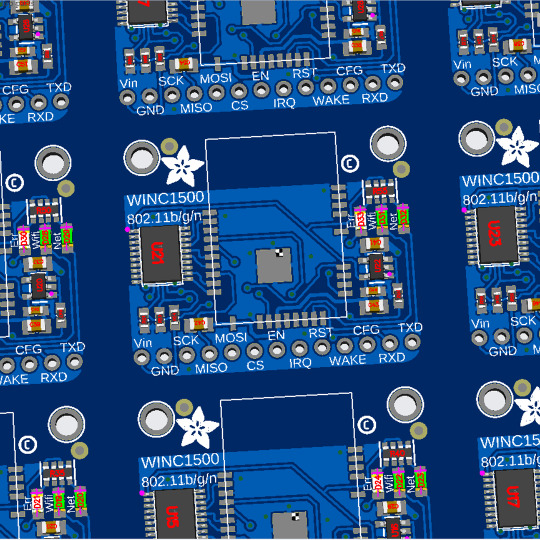

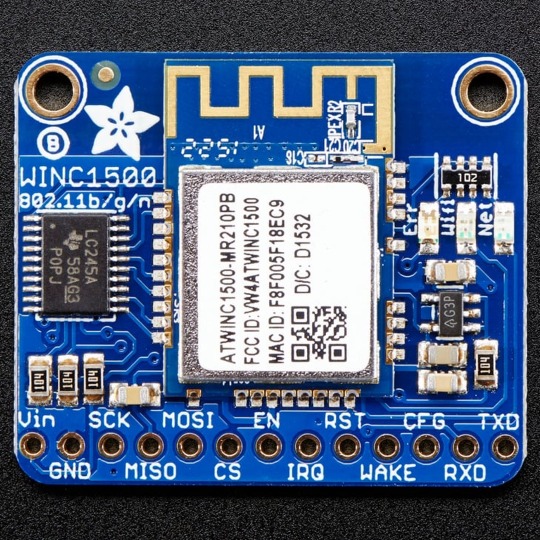
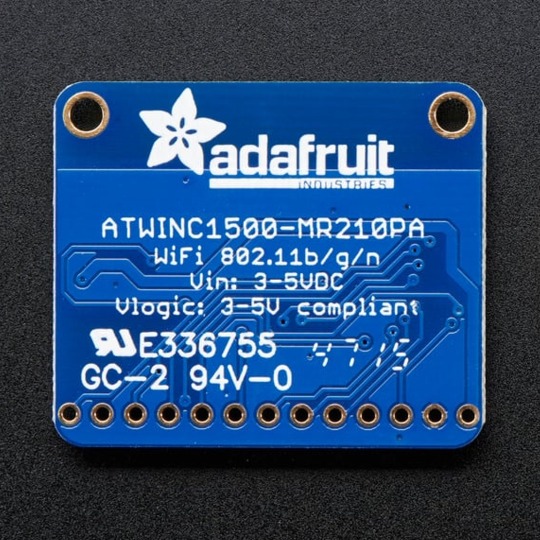
PCB of the Day! ATWINC1500 WiFi Breakout 🔌🌐🛠
Connect your development boards to the Internet with this fine WiFi module. This 802.11bgn-capable WiFi module is the best new thing for networking your devices, with SSL support and rock solid performance.
#adafruit#electronics#opensource#opensourcehardware#pcboftheday#pcb#wifi#arduino#internetofthings#iot#networking#tech#innovation#diy#maker#wireless
2 notes
·
View notes
Text

ATMEGA328P-AU Embedded System for Atemel IC Distributor Atmega328p specification:IC MCU 8BIT 32KB FLASH 32TQFP. Core Processor:AVR Core Size:8-Bit Speed:20MHz Connectivity:I2C, SPI, UART/USART Peripherals:Brown-out Detect/Reset, POR, PWM, WDT Number of I/O:23 Program Memory Size:32KB (16K x 16) Program Memory Type:FLASH EEPROM Size:1K x 8 RAM Size:2K x 8 Voltage - Supply (Vcc/Vdd):1.8V ~ 5.5V Data Converters:A/D 8x10b Oscillator Type:Internal Operating Temperature:-40°C ~ 85°C (TA) Mounting Type:Surface Mount Package:32-TQFP (7x7) Atmega328 Datasheet here. Note:Online picture for date code only for refference,different lot date code meybe differenct than online picture.All date code or lot number is as actual received shipment. Besides,if you didn't find the correct mcu parts number in our site online,you can also chat with us to confirm due to there are much more inventory parts list maybe not list online yet.Know more business about us. About ATMEGA328P-AU Online Price and MOQ: As for MOQ you see in the quantity blanket,MOQ of this atmega328 mcu is 100 units,if you interested with much more quantity than MOQ online,welcome to chat with us via whatsapp to consult the best support. ...... Other more electronic components inventory stock are not able to post online,welcome drop us email or chat via whatsapp to know more. About Payment: We usually accept bank transfer,credit card payment,like Visa,MasterCard.,Western Union etc. About Warranty: All the parts provided are same quality as original,so quality is same as offical 1 year warranty. About Us: Chengsuchuang are relable and trustworth electronics hardware supplier from China,we are in the electronic components fields since 2014 year,and got lots of experience in the electronics hardware supply chain.If you are looking for something else about other pcb project for the electronic components bom list,they are also available to supply.Integrated circuits including power ic, logic ic, control ic, driver ic, monitor ic, inerface ic etc.MCU including consumer electronics project,industrial,automobile and medical fields etc. The electronic components distribution brand including ADI,Micron,Samsung,Atmel, Microchip, ST, TI, NXP, INFINEON,Cypress,Altera,Xilinx,ON,TDK,Toshiba,Panasonic etc.The more interested parts number quotation request,welcome drop us email to send a enquiry. If you are looking for a reliable and trustworth ic supplier,then this is a good place you comes.Contact us to talk via whatsapp with sourcing request for quotation,we'll respond you soon. Know more about company product catagory here. Read the full article
0 notes
Text
First ATTINY85 project!
(warning: video has actual flashing LED lights)
[ Video ID: A breadboard with a Blue LED on top of an 8-pin DIP Integrated Circuit on it. The Blue LED is flashing rapidly. There are other components on the breadboard in the background. End ID ]
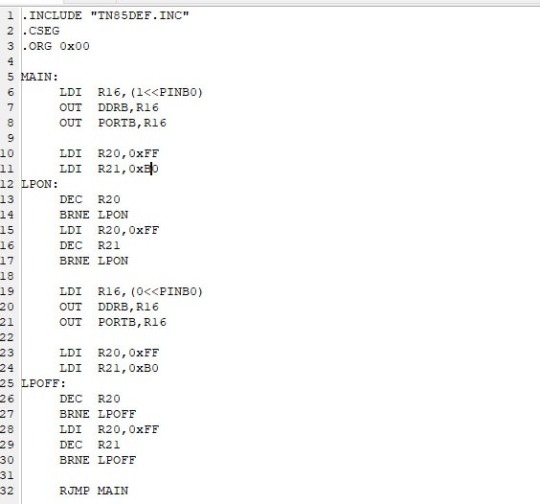
Last week I bought some ATTINY85 Microprocessors to experiment and work with :) With my W65C02 project on hold until I can afford an oscilliscope, and my Radio project delayed because I can’t quite figure out how to reverse engineer the 8 pins on the volume knob, I wanted something else to work with. I’ve been wanting to mess with Atmel microprocessors (Arduino Uno runs on an Atmel ATMEGA328), and now’s a good chance!
I��m jumping straight to assembly with the ATTINY85; I don’t know any C/C++ code, and also I’m familiar with other processor Assembly languages, so I might as well. And other than different names for functions, it’s been pretty easy so far! Something I’m not used to is that this processor, despite being pathetically tiny, has 32 registers; I’m used to working with 8 Max.
Anyways, for the code explanation: When the processor first starts, it turns on PINB0, which is physical pin 5 on the processor. Then, after counting to 256 256 times, it turns off PINB0 for another 256^256 counts. I’m away from home while writing this, so my notes arn’t here, but if I remember correctly it came up to 200k microseconds? That adds up to about 400 nano seconds per on/off cycle, or 2.5 flashes per second. I can add in another loop to make it last longer, but before I do that I’d like to look about to see if there’s a smarter way to tackle this.
My next step after this, is to figure out how to get this processor to read digital inputs: My next project is to finally do something with my box of telephone rotary dials. I already have one spec’ed out for breadboard testing. I would LOVE to show it, but Tumblr has a One Video Per Post limit :(
13 notes
·
View notes
Text
FreeRTOS
FreeRTOS – a real-time operating system for embedded devices https://archiveos.org/freertos/
1 note
·
View note
Text
The icsp-pins on the arduino make no sense. I mean, I know they share similar-architecture to the spi-protocol, but why not just program your arduino through the midi-port, or whatever? Theory: this method is more efficient for programming multiple microcontrollers - say, for production.

1 note
·
View note
Text
Tastets de pollastre al curry
Ingredients: 1 Ceba de Figueres mitjana ½ Pebrot groc 2 Pits de pollastre Crema de llet 1 Culleradeta de curry Oli d’oliva verge extra Sal i pebre Atmelles salades Arròs blanc per acompanyar Preparació: Jo ho he preparat en un wok, però es pot fer en una paella normal i corrent. Primer de tot tallem el pollastre en daus, els sal pebrem i els fregim amb oli d’oliva i ho reservem. Tot seguit…

View On WordPress
#AMETLLES#ARROS#AVIRAM#CEBA#CREMA DE LLET#CUINA#CURRI#FRUITA SECA#LACTIC#OLI#OLI D&039;OLIVA#PEBRE NEGRE#PEBROT#PIT DE POLLASTRE#PLATS UNICS#POLLASTRE#RECEPTA#SAL#SEGONS PLATS#VERDURA
0 notes
Text
Última Llum, entre atmellers
atardecer #sunset #capvespre #vesprada #soirée #bluehour #blue #colorsdelpaisatge #paisajesvalencianos #natura #nature #naturaleza #baixmaestrat #castelló #atmeller #flowers #flor #tree #arbres #skyline #cabanes #pedraseca #vidarural #bancal





#Última Llum#entre atmellers#atardecer#sunset#capvespre#vesprada#soirée#bluehour#blue#colorsdelpaisatge#paisajesvalencianos#natura#nature#naturaleza#baixmaestrat#castelló#atmeller#flowers#flor#tree#arbres#skyline#cabanes#pedraseca#vidarural#bancal#paísvalencià#turismecomunitatvalenciana#light#stonewall
1 note
·
View note
Text
HTE UNO R3 Development Board V1.0 | Powerful Arduino-Compatible Circuit for DIY Projects
HTE UNO R3 Development Board v1.0 The HTE UNO R3 DEV 1.0 is your ideal Arduino-compatible PCB for building reliable and efficient electronics projects. Designed to support popular Atmel microcontrollers like ATmega8, ATmega48, ATmega88, ATmega168, and ATmega328, it provides unmatched flexibility for various DIY and educational applications. The HTE UNO Development Board v1.0 integrates smoothly…
0 notes